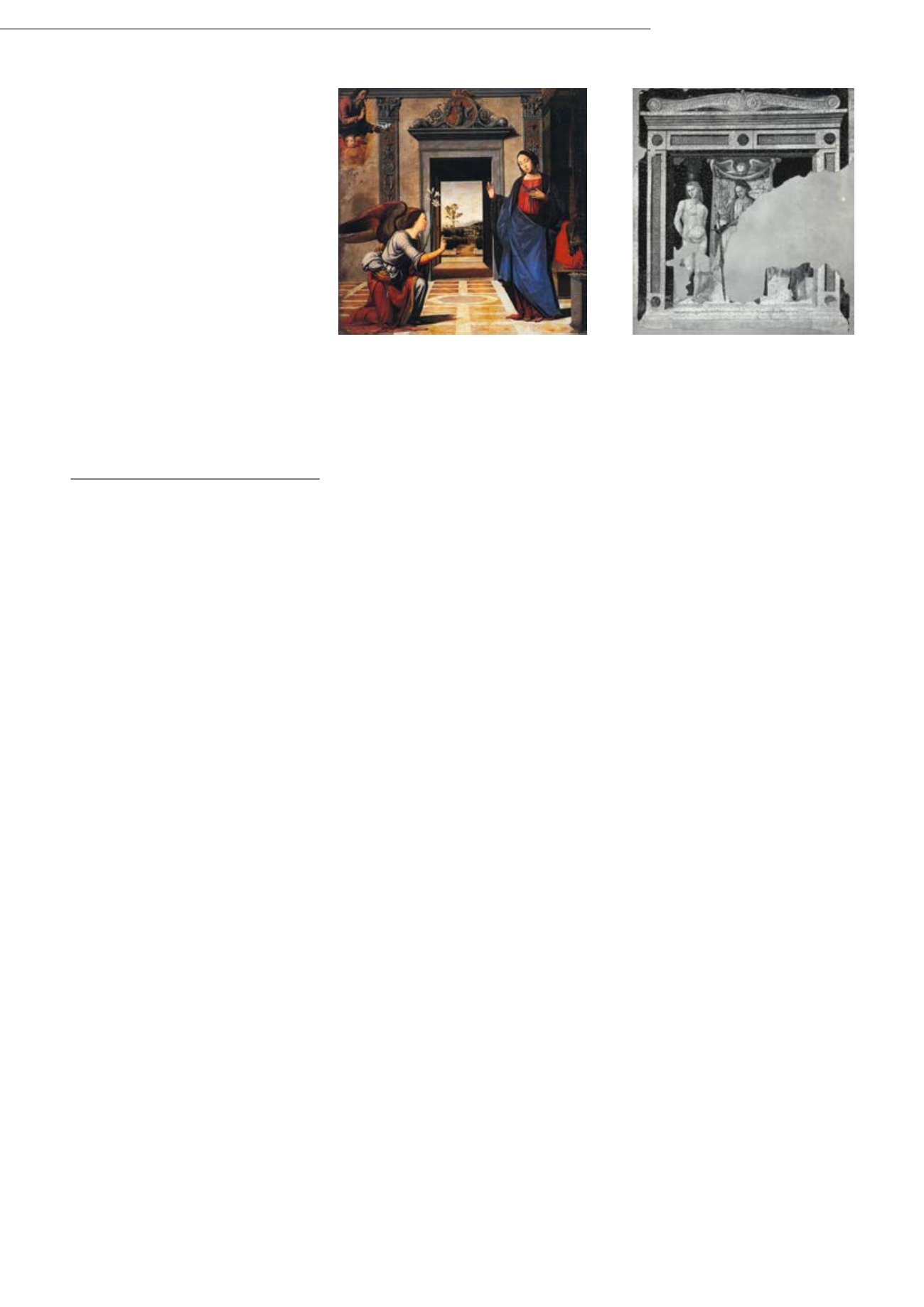
 3012*
SIGNORACCIO, LEONARDO DI BER-
NARDINO DEL called LEONARDO DI
BERNARDINO DA PISTOIA
3012*
SIGNORACCIO, LEONARDO DI BER-
NARDINO DEL called LEONARDO DI
BERNARDINO DA PISTOIA
(Baptized in 1491 in Pistoia)
The Annunciation.
Oil and gold ground on panel.
Signed lower centre: LEONARDVS F. BER-
NARDINI DEPiSTORio P.
177.7 x 148.5 cm.
Provenance:
- Private collection, Genoa, 1878.
- Auction market, London, 1890s.
- Collection of Tomás Harris, London.
- Collection of Otto Froehlich, Vienna.
- Private collection, Spain, 1927 (acquired for
425,000 pesetas).
- By inheritance, European private collection.
- Swiss private collection.
Literature:
- Capponi, V.: Biografia Pistoiese, Pistoia 1878,
p. 421.
- Nerucci, G.: Bollettino storico pistoiese, I,
1899, p. 160.
- Gronau, G. D.: Una tavola di scuola pistoiese,
in: Rivista d‘Arte, Jahr XI, no. 2, April - June
1929, pp. 214-219, fig. 1.
- D‘Afflito, C., Falletti, F., Muzzi, A.: L‘Età di
Savonarola: Fra‘ Paolino e la Pittura a Pistoia
nel primo ‚500, exh. cat. Pistoia, Palazzo Co-
munale, 24.4.- 31.7.1996, pp. 141 and 143.
The painting offered here, which reemerged a
few years ago after several decades in a Spanish
private collection, is the only known signed
work of the Tuscan master Leonardo di Ber-
nardino da Pistoia and thus of extraordinary art
historical significance for the reconstruction of
his oeuvre. A recent, thorough conservation has
also brought the excellent preservation of this
panel to light.
Leonardo di Bernadino da Pistoia was the bro-
ther of the famous painter Fra‘Paolino da Pistoia
(1490-1547). Both were trained by their father
Bernardino del Signoraccio. The influence of
the father is evident not least in the signature
of our painting, embedded cleverly as a nested
calligraphy in the architecture. This unusual
feature can be found frequently in the works of
Bernardino del Signoraccio, as well as the de-
tailed architectural elements and finely executed
figures, as seen in his Sacra Conversazione in
the Church of San Vitale in Pistoia, which was
probably created shortly before our painting (see
D‘Afflito, et al. 1996, cat. no. 11, pp. 138-140).
Leonardo di Bernardino‘s work would not be
possible without the painting of the Floren-
tine master Fra Bartolomeo (1472-1517). The
influence of the Tuscan master is noticeable in
our painting in several respects, especially when
compared with his Annunciation executed in
1497 in the Cathedral of Volterra (see illustration
1, Padovani, S.: Fra Bartolomeo e la Scuola di
San Marco, exh. cat. Florence 1996, cat. no.
6, pp. 57-60, with fig.). In our composition the
Archangel is kneeling in the same position as in
Fra Bartolomeo‘s model; also the blessing figure
of God and the Holy Spirit in the form of a
dove in the top left corner can be found in both
compositions. By contrast, the interior in which
our scene is situated differs greatly from Fra
Bartolomeo‘s open background with a view of an
Italian landscape. The architectural background
here chosen by Leonardo di Bernardino gives
the scene a markedly more contemplative and
devotional character, which is enhanced by the
symmetry of the arches and the elegant gold
embellishments. The body language of Maria
also shows Leonardo di Bernardino‘s artistic
Abb. 1
Abb. 2
independence. The influence of both composi-
tions makes itself felt finally in the Annunciation
datable to ca. 1520, which is now attributed to
Giovanni Antonio Sogliani (see Padovani 1996
cat. no. 89, pp. 266-268). In it are found again
both the position of the figures from Leonardo
di Bernardino‘s composition, as well as the open
background of Fra Bartolomeo‘s painting.
Overall, very few other works by Leonardo di
Bernardino da Pistoia are known: A Saint Irene
was auctioned at Christie‘s London in 1899 (see
Gronau 1929, p. 5, fn. 1); a Sacra Conversazio-
ne, whose attribution intermittently fluctuated
between Fra ‚Paolino and Bernardino del Signo-
raccio, located in the Chiesa di Santa Maria As-
sunta in Lizzano (see D‘Afflito et al., 1996, cat.
no. 13, p. 141, fig. p. 142); and finally a fresco in
the Chiesa di Santa Maria a Ripalta in Pistoia
(see illustration 2, ibid., cat. no. 14, p. 143).
The attributions of these works to Leonardo di
Bernardino del Signoraccio are based without
exception upon stylistic comparison with the
work offered here, the only one signed, which
was known until its rediscovery only through
black and white photographs. However, none of
his works previously discovered is comparable in
terms of quality and level of detail to the major
work by the artist offered here, which is a prime
example of Tuscan Renaissance painting.
CHF 180 000 / 250 000
(€ 166 670 / 231 480)
Gemälde Alter Meister
| 16
















